2007 marked another year of accomplishment and growth, tempered
by the passing of old friends, for NASA's Dryden Flight Research
Center at Edwards Air Force Base. In 2007, NASA Dryden supported a
number of research projects and environmental science efforts,
gathering and analyzing data that contributed to aerospace
technology, the agency's space exploration goals and the knowledge
and protection of our environment. Now in its seventh decade as
NASA's lead center for atmospheric flight research and operations,
NASA Dryden is actively engaged in all four of NASA's mission
concentrations, exploration systems, space operations, aeronautics
research, and science.
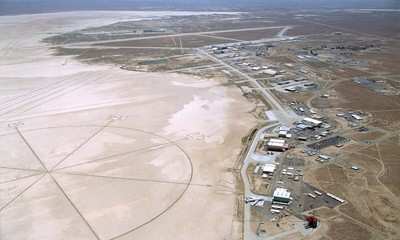
Exploration Systems
Dryden has a critical role in the early development of NASA's
Constellation Program systems. Applying Dryden's expertise with
testing unique flight configurations, Dryden is helping to manage
and implement the abort system flight tests for the Orion crew
module, the first new manned spacecraft since the Space Shuttle.
Dryden manages procurement and oversees development of the
solid-fuel abort test boosters used for ascent abort testing and is
responsible for the integration of the Orion test articles with
their booster rockets.
Facilities construction began for the Orion abort flight tests
at the U.S. Army's White Sands Missile Range in New Mexico in early
October. Dryden is leading the development and integration of the
full-size Orion test articles, along with development of the ground
support equipment, flight instrumentation and launch facility
construction for the Pad Abort and all Ascent Abort flight
tests.
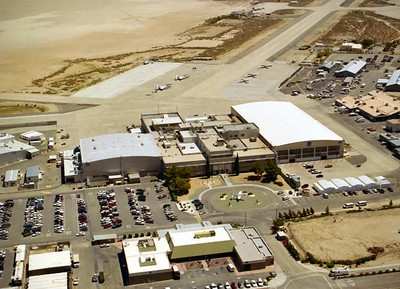
The completed Orion flight test boilerplate module is scheduled
to arrive at Dryden in early 2008. While here, technicians will
install the flight computers, instruments, and other electronics in
preparation for flight tests at White Sands next fall. Future
Dryden support roles include Orion lunar heat shield and skip entry
flight tests, Lunar Lander flight testing, Orion parachute drop
test, flight simulation support of the Constellation training
facility and west coast recovery operations.
Space Operations: STS-117 Landing
Space Shuttle Atlantis landed at Edwards/Dryden on June 22, 2007
to conclude mission STS-117 to the International Space Station. The
mission delivered the second starboard truss segment and energy
systems as well as the S3/S4 Truss and a set of solar arrays to the
station.
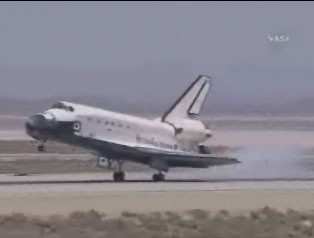
Aeronautics Research: X-48B Blended Wing Body
The first flight of the X-48B Blended Wing Body sub-scale
research aircraft on July 20, 2007 inaugurated a flight research
program on the unique design. After initial flight-envelope
expansion and various software and hardware upgrades, flight
testing of the 21-foot wingspan, 500-pound, remotely piloted test
vehicle will continue well into 2008.
The X-48B is a hybrid configuration that combines the best
attributes of a conventional tube-and-wing aircraft with a flying
wing. It has the potential to meet expected future Next Generation
Air Transportation System requirements for low noise, low emissions
and high performance. The X-48B Blended Wing body is a
collaborative effort involving the Boeing Co. which designed the
craft, NASA's Fundamental Aeronautics Program and the Air Force
Research Laboratory at Wright Patterson Air Force Base, Ohio.
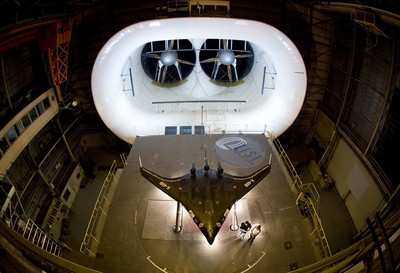
Sonic Boom Tests
NASA Dryden researchers examined the structural response of
modern housing construction to both normal and low-amplitude sonic
booms in the Housing Structural Response to Sonic Booms Test
project from July 11 to July 20. The experiment consisted of NASA
F-18 research aircraft flying unique profiles in order to present
sonic booms to an Edwards Air Force base house instrumented to
measure both pressure and vibration.
Science: SOFIA Arrival and Flight Tests
NASA's Stratospheric Observatory for Infrared Astronomy, or
SOFIA, arrived at NASA Dryden May 31 from Waco, Texas, where L-3
Communications Integrated Systems installed a German-built
2.5-meter infrared telescope and made other major modifications
over the past several years. The aircraft started a series of
flight tests in October to confirm the structural integrity and
performance of the highly modified Boeing 747SP aircraft with the
telescope cavity door closed.
Following a couple of flights in December and January to check
the functionality of the telescope in flight, the SOFIA will be
transferred to its base of operations at Dryden's new Aircraft
Operations Facility in Palmdale, Calif. Installation of mission
systems and further flight tests in 2008 and 2009 with the
telescope cavity door open will verify that the unique airborne
observatory is ready to perform its future astronomical science
mission.
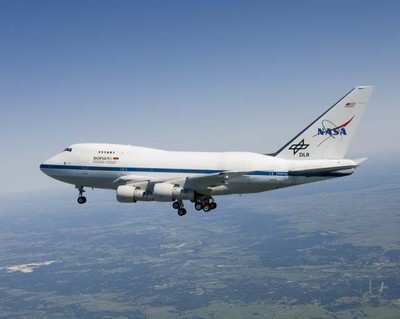
Ikhana Arrival and Wildfire Missions Support
After arriving at NASA Dryden in June, the Ikhana, a Predator B
unmanned aircraft system adapted for civil science and research
missions, was quickly put to operational use. Equipped with
sophisticated infrared imaging equipment, Ikhana flew a series of
wildfire imaging demonstration flights over the western states, and
then assisted firefighters battling several large Southern
California wildfires in October in response to a request from the
California Office of Emergency Services and the National
Interagency Fire Center.
Dryden Aircraft Operations Facility
In September, NASA Dryden leased a portion of the former
Rockwell International / North American Aircraft B-1B production
plant in Palmdale, Calif., from Los Angeles World Airports for a
new Aircraft Operations Facility. NASA signed a 20-year lease on
the property, which consists of a large hangar and office building
and related infrastructure on 16.2 acres. Five of Dryden's
environmental and space science aircraft will be based at the
facility in the coming year.
The facility has immediate access to the adjacent U.S. Air Force
Plant 42 and its two 12,000-ft runways, subject to Air Force
procedures. With over 210,000 square feet of hangar space and an
equivalent amount of space for offices, labs, conference
accommodations and storage, the facility is ideal for collaborating
with industry, visiting scientists and researchers, and
aviation-related activities. Dryden anticipates this facility will
become valuable to aerospace and aviation-related businesses
looking for a new location or expansion opportunity.
NASA's DC-8 Airborne Laboratory Returns to Dryden
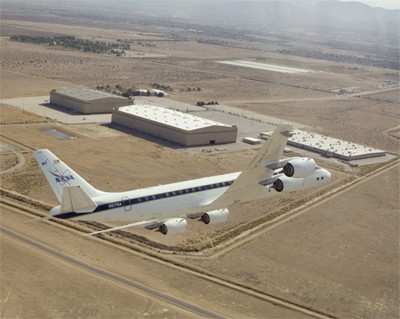
NASA's DC-8 airborne science laboratory returned to NASA's
Dryden Nov. 8 after an absence of more than two years. The
University of North Dakota had managed the flying science lab's
missions since late 2005, although Dryden flight crews continued to
operate the aircraft on worldwide missions. The converted jetliner
is the first science aircraft to be based at Dryden's new Aircraft
Operations Facility.
Educational Outreach
NASA Dryden continued efforts to improve science and mathematics
education during 2007. Dryden welcomed two new NASA Explorer
Schools, San Cayetano middle school in Fillmore, Calif., and
Vintage Magnet School in North Hills, Calif. Two teachers from
Arrowhead Elementary, a NASA Explorer School in Phoenix, Ariz.,
along with a Dryden education specialist, flew a student/teacher
experiment aboard NASA's DC-9 reduced gravity aircraft in
February.
In Memoriam
The center's staff bid a final farewell to several members of
the Dryden family whose contributions cover more than 60 years of
innovative engineering and piloting accomplishments at Dryden.
Among them were former NASA Dryden engineer William P. Albrecht,
who died July 16 at the age of 83. Retired NASA Dryden engineer and
acting director De E. Beeler passed away on Sept. 11 at the age of
92. Former NASA Dryden research pilot Stanley P. Butchart died Oct.
1 in Lancaster at the age of 85. NASA Dryden research pilot Edwin
W. Lewis Jr. died Nov. 8 at the age of 71, in the crash of a Civil
Air Patrol plane southwest of Las Vegas, only hours after he led
the flight crew in flying NASA's DC-8 science laboratory back to
Dryden. Their legacy will live on as NASA Dryden moves forward into
the future of aerospace research in 2008.
 ANN's Daily Aero-Term (04.20.24): Light Gun
ANN's Daily Aero-Term (04.20.24): Light Gun Aero-News: Quote of the Day (04.20.24)
Aero-News: Quote of the Day (04.20.24) ANN's Daily Aero-Linx (04.21.24)
ANN's Daily Aero-Linx (04.21.24) Aero-News: Quote of the Day (04.21.24)
Aero-News: Quote of the Day (04.21.24) ANN's Daily Aero-Term (04.21.24): Aircraft Conflict
ANN's Daily Aero-Term (04.21.24): Aircraft Conflict








